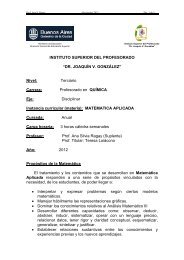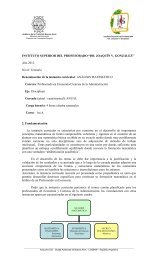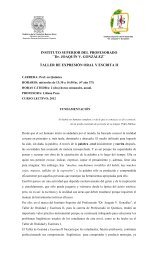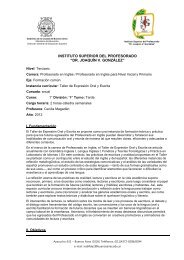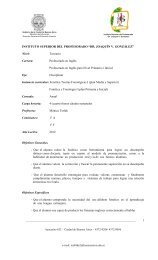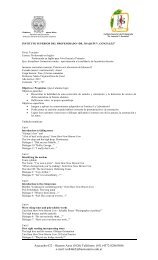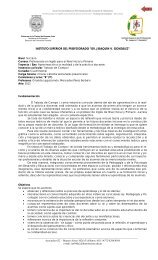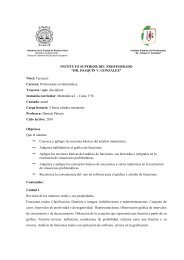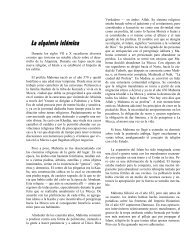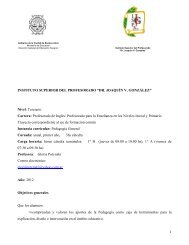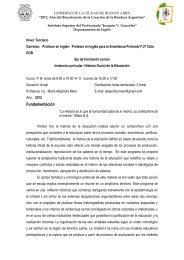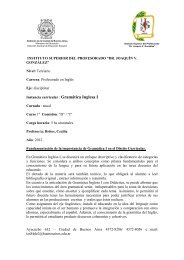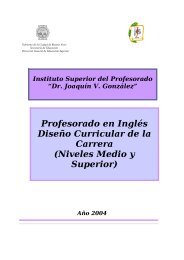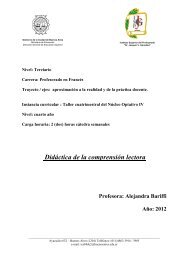Los retos de la historia oral en el siglo XXI: diversidades ...
Los retos de la historia oral en el siglo XXI: diversidades ...
Los retos de la historia oral en el siglo XXI: diversidades ...
Create successful ePaper yourself
Turn your PDF publications into a flip-book with our unique Google optimized e-Paper software.
Sesiones parale<strong>la</strong>s / Parall<strong>el</strong> sessionsjust as people have biographies that can be researched and docum<strong>en</strong>ted. Suchinvestigations discover and reveal the g<strong>en</strong>ealogies, histories and accounts ofthe object being examined; can fill gaps and give voice to sil<strong>en</strong>ces on the historicalrecord; foster broa<strong>de</strong>r and more imaginative questioning, analysis andinterpretation, and allow for differing stories to therefore emerge. Such discoveriesare un<strong>de</strong>rtak<strong>en</strong> using a multitu<strong>de</strong> of sources – docum<strong>en</strong>tary, illustrative,<strong>oral</strong> and ev<strong>en</strong> s<strong>en</strong>sory – that together bring objects to life, since without suchilluminations objects are mer<strong>el</strong>y things that <strong>la</strong>ck the context and personal historythat make each one unique. Oral history is a methodology that not onlysupplem<strong>en</strong>ts other historical sources but can stimu<strong>la</strong>te the positing of furtherquestions; cover a plethora of subject matter; <strong>en</strong>rich our knowledge and addfurther dim<strong>en</strong>sions to the story that was accumu<strong>la</strong>ted via the docum<strong>en</strong>taryevi<strong>de</strong>nce. Oral history can th<strong>en</strong> be se<strong>en</strong> as an important resource wh<strong>en</strong> investigatingthe life course of objects in the production an object biography. Objectsas inanimate <strong>en</strong>tities, do not have voices of their own, but can ‘speak’ througha <strong>la</strong>byrinth of interwov<strong>en</strong> stories that can be embroi<strong>de</strong>red into a biography.These stories are the <strong>la</strong>yers of memories and recor<strong>de</strong>d narratives of the peopleand communities who were intimate with the object, with each collectiv<strong>el</strong>yrevealing the changing meanings and rich history of a person, group or localethat has be<strong>en</strong> associated with a particu<strong>la</strong>r object. With a focus on severalSouth Australian objects such as the May<strong>oral</strong> Chair of Port Pirie; the Burra Hallwhich was erected as part of the Cheer-Up Society building in A<strong>de</strong><strong>la</strong>i<strong>de</strong>, duringthe First and Second World Wars, and a piece of sheet music, this paper wil<strong>la</strong>rgue that <strong>oral</strong> history methodologies are an integral compon<strong>en</strong>t in the historicalinvestigation of objects. Further, by allowing the audi<strong>en</strong>ce to hear thevoices of the people associated with each of these objects, this pres<strong>en</strong>tationwill show how the result is a more <strong>en</strong>hanced, informed and fleshed out objectbiography that is no longer mute and inanimate but a witnesses to the pastthat can t<strong>el</strong>l us of its historical significance.CASTRO, Magali <strong>de</strong>El mito <strong>de</strong> <strong>la</strong> era <strong>de</strong>l oro: <strong>la</strong>s memorias <strong>de</strong> antiguasmaestras sobre <strong>el</strong> asunto <strong>de</strong>l su<strong>el</strong>do y <strong>de</strong> <strong>la</strong> posiciónsocial <strong>de</strong>l maestro primario <strong>de</strong>l principio <strong>de</strong>l <strong>siglo</strong> XXEl asunto <strong>de</strong>l su<strong>el</strong>do <strong>de</strong>l maestro primario brasileño es un problema histórico.Si consi<strong>de</strong>ró <strong>la</strong> realidad social y económica actual, respecto al <strong>de</strong>l principio<strong>de</strong>l vigésimo <strong>siglo</strong>, se verifica que, por ese tiempo, <strong>el</strong> su<strong>el</strong>do <strong>de</strong> los maestrosera mejor que ahora, sin embargo no consiguió ser tan privilegiado como hagacreer <strong>la</strong>s nociones <strong>de</strong> s<strong>en</strong>tido común, según que <strong>el</strong> viejo maestro primario t<strong>en</strong>íaun su<strong>el</strong>do muy bu<strong>en</strong>o. Buscando investigar sobre <strong>el</strong> su<strong>el</strong>do y <strong>la</strong> posiciónsocial <strong>de</strong> los maestros primarios <strong>en</strong> <strong>el</strong> principio <strong>de</strong>l vigésimo <strong>siglo</strong>, se investigódieciocho maestras <strong>de</strong> Minas Gerais, Brasil, con <strong>la</strong> edad <strong>en</strong>tre 63 y 92 años,formó <strong>en</strong> <strong>el</strong> curso <strong>de</strong> magisterio <strong>de</strong> niv<strong>el</strong> medio, <strong>en</strong>tre los años 1930 y 1958. E<strong>la</strong>cercami<strong>en</strong>to metodológico <strong>de</strong> <strong>la</strong> Historia Oral fue adoptado, con <strong>en</strong>trevistasabiertas, dón<strong>de</strong> <strong>la</strong>s narrativas permitieron al uso <strong>de</strong> <strong>la</strong> memoria como <strong>el</strong> factordinámico <strong>de</strong> <strong>la</strong> interacción <strong>en</strong>tre pasado y pres<strong>en</strong>te. En este trabajo, se pres<strong>en</strong>tanalgunos <strong>de</strong>safíos <strong>en</strong>fr<strong>en</strong>tados <strong>en</strong> <strong>el</strong> <strong>de</strong>sarrollo <strong>de</strong> <strong>la</strong> Historia Oral y <strong>la</strong>sreve<strong>la</strong>ciones <strong>de</strong> los maestros sobre <strong>el</strong> ejercicio <strong>de</strong> <strong>la</strong> <strong>en</strong>señanza, su posiciónsocial y su su<strong>el</strong>do. Para <strong>el</strong>los, hay una difer<strong>en</strong>cia <strong>en</strong>tre <strong>el</strong> pasado y <strong>el</strong> pres<strong>en</strong>te<strong>en</strong> <strong>la</strong> posición social y <strong>en</strong> <strong>el</strong> ejercicio <strong>de</strong> <strong>la</strong> profesión <strong>de</strong>l maestro. Sin embargo,<strong>el</strong> asunto <strong>de</strong> los su<strong>el</strong>dos bajos se vu<strong>el</strong>ve empeorando, pero no es un nuevo problema:los maestros primarios siempre t<strong>en</strong>ían los su<strong>el</strong>dos malos, si consi<strong>de</strong>rósu importancia <strong>en</strong> <strong>la</strong> construcción <strong>de</strong> <strong>la</strong> sociedad y <strong>de</strong>l futuro <strong>de</strong> <strong>la</strong> nación.The Brazilian <strong>el</strong>em<strong>en</strong>tary school teachers wage subject is a historical problem.If we consi<strong>de</strong>r the curr<strong>en</strong>t social and economical reality re<strong>la</strong>ted to the one onthe beginning of tw<strong>en</strong>tieth c<strong>en</strong>tury, we verify that, at that time, the teachers’wage was better than now, however it wasn’t as privileged as the notions ofcommon s<strong>en</strong>se used to b<strong>el</strong>ieve, according to which the <strong>el</strong>em<strong>en</strong>tary school teachersused to have a very good sa<strong>la</strong>ry. Looking for investigating about wageand social position of the <strong>el</strong>em<strong>en</strong>tary school teachers on the beginning of thetw<strong>en</strong>tieth c<strong>en</strong>tury, eighte<strong>en</strong> teachers from Minas Gerais, Brazil were researched.They were betwe<strong>en</strong> 63 and 92 years old, graduated in the Teaching Regu<strong>la</strong>rCourse from 1930 to 1958. The methodological approach of the Oral Historywas adopted and op<strong>en</strong> interviews were accomplished. The narratives allowedthe use of the memory as a dynamic factor of interaction betwe<strong>en</strong> past andpres<strong>en</strong>t. In this paper, are pres<strong>en</strong>ted some chall<strong>en</strong>ges faced in the <strong>de</strong>v<strong>el</strong>opm<strong>en</strong>tof the Oral History and teachers’ reve<strong>la</strong>tions about the exercise of teaching,their social position and their wage. For them, there is a differ<strong>en</strong>ce betwe<strong>en</strong>the past and the pres<strong>en</strong>t according to social position and the teachingexercise. However, the low wages issue becomes worse, but this is not a newproblem: the <strong>el</strong>em<strong>en</strong>tary school teachers always got bad wages, if we consi<strong>de</strong>rtheir importance in the construction of society and nation’s future.PADILLA ARROYO, AntonioMemorias <strong>en</strong> <strong>el</strong> cristal: juegos infantiles, cultura materialy disciplina <strong>de</strong>l cuerpoPor medio <strong>de</strong> <strong>la</strong> <strong>historia</strong> <strong>oral</strong> <strong>el</strong> pres<strong>en</strong>te trabajo reconstruye <strong>la</strong> memoria <strong>de</strong>algunos miembros <strong>de</strong> distintas g<strong>en</strong>eraciones que nacieron y crecieron <strong>en</strong> <strong>el</strong>s<strong>en</strong>o <strong>de</strong> familias <strong>de</strong> trabajadores y artesanos que habitaron una colonia, <strong>la</strong>Colonia Mo<strong>de</strong>rna, <strong>en</strong> <strong>la</strong> ciudad <strong>de</strong> México, qui<strong>en</strong>es fueron testigos y protagonistas<strong>de</strong> <strong>la</strong> urbanización, introducción y dotación <strong>de</strong> servicios públicos <strong>en</strong> esazona. Por medio <strong>de</strong> <strong>la</strong>s narrativas <strong>oral</strong>es es posible reconstruir <strong>la</strong>s viv<strong>en</strong>cias <strong>de</strong>los infantes durante <strong>la</strong> segunda mitad <strong>de</strong>l <strong>siglo</strong> XX, <strong>la</strong>s cuales nos aproximana compr<strong>en</strong><strong>de</strong>r <strong>la</strong> importancia <strong>de</strong>l juego infantil como configuración cultural,según <strong>la</strong> <strong>de</strong>finición que ofrece Norbert Elías, como campo, <strong>en</strong> s<strong>en</strong>tido <strong>de</strong> PierreBourdieu, o <strong>de</strong> dispositivo, <strong>de</strong> acuerdo con Mich<strong>el</strong> Foucault.Ti<strong>en</strong>e <strong>en</strong>tre sus objetivos reconstruir <strong>la</strong>s repres<strong>en</strong>taciones y <strong>la</strong>s prácticas individualesy colectivas y, <strong>de</strong> ese modo, recobrar <strong>la</strong>s experi<strong>en</strong>cias <strong>de</strong> niños yniñas <strong>en</strong> torno a los juegos, <strong>el</strong> significado y <strong>el</strong> s<strong>en</strong>tido que se le confier<strong>en</strong> y <strong>el</strong>lugar que ocupan <strong>en</strong> los recuerdos. Des<strong>de</strong> esta perspectiva, los juegos infantilesse concib<strong>en</strong> como aparatos <strong>de</strong> transmisión <strong>de</strong> <strong>la</strong> her<strong>en</strong>cia cultural <strong>en</strong>treg<strong>en</strong>eraciones que, por lo regu<strong>la</strong>r, se reproduce <strong>en</strong>tre los grupos <strong>de</strong> edad, <strong>de</strong> losmayores a los m<strong>en</strong>ores. A partir <strong>de</strong> los recuerdos se trata <strong>de</strong> estudiar los juegosinfantiles como espacios socializadores y <strong>de</strong> sociabilidad.Mediante estos se analizan ámbitos <strong>de</strong> conviv<strong>en</strong>cia comunes y <strong>la</strong>s divisiones<strong>de</strong> género, los modos <strong>de</strong> or<strong>de</strong>nami<strong>en</strong>to <strong>de</strong>l mundo y los roles que se le asignan.En este texto se <strong>de</strong>staca <strong>la</strong> capacidad <strong>de</strong> <strong>la</strong> niñez y que se <strong>de</strong>spliega <strong>en</strong> tresniv<strong>el</strong>es <strong>de</strong> análisis: primero, <strong>en</strong> los procesos <strong>de</strong> producción cultural, esto es,como productores <strong>de</strong> l<strong>en</strong>guajes con sus narrativas, signos, símbolos, gestos yrituales; segundo, como g<strong>en</strong>erador <strong>de</strong> productos materiales y, por añadidura,<strong>de</strong> artefactos físicos que exhibe su pot<strong>en</strong>cial para <strong>la</strong> innovación tecnológica;tercero, como dispositivo para disciplinar y mol<strong>de</strong>ar <strong>el</strong> cuerpo <strong>en</strong> <strong>el</strong> que se <strong>en</strong>carnan<strong>de</strong>strezas disposiciones para su integración social.By means of <strong>oral</strong> history the pres<strong>en</strong>t work recovers the memory of severalmembers of differ<strong>en</strong>t g<strong>en</strong>erations that were born and grew in families ofworkers and craftsm<strong>en</strong> who inhabited a district, Mo<strong>de</strong>rn District, that lived anatmosphere of urbanization, of introduction and grant of services public. Bymeans of the <strong>oral</strong> narratives it is possible to reconstruct the experi<strong>en</strong>ces ofthe infants during second half of c<strong>en</strong>tury XX in the city of Mexico and approximatesthat us including/un<strong>de</strong>rstanding to it of the importance of the infantilegame like cultural configuration, according to the <strong>de</strong>finition that offers NorbertElías, like fi<strong>el</strong>d, in s<strong>en</strong>se of Pierre Bourdieu, <strong>de</strong>vice, in agreem<strong>en</strong>t with Mich<strong>el</strong>Foucault. It must betwe<strong>en</strong> his objectives reconstruct the individual and collectiverepres<strong>en</strong>tations and practices and, that way, recover the experi<strong>en</strong>ces ofchildr<strong>en</strong> and childr<strong>en</strong> around the games, the meaning and the s<strong>en</strong>se that areconferred to him and the p<strong>la</strong>ce that occupy in the memories.From this perspective, the infantile games conceive like transmitters of thecultural inheritance betwe<strong>en</strong> g<strong>en</strong>erations that, by regu<strong>la</strong>ting, reproduce betwe<strong>en</strong>the age groups, of the majors the minors. From the memories one is tostudy the infantile games like socializing spaces and of sociability. By means ofthese the common scopes of coexist<strong>en</strong>ce and the divisions of sort are analyzed,the ways of or<strong>de</strong>ring of the world and the rolls that are assigned to him.In this text the capacity of the childhood stands out and that unfolds in thre<strong>el</strong>ev<strong>el</strong>s of analysis: first, in the processes of cultural production, that is to say,like producers of <strong>la</strong>nguages with its narratives, signs, symbols, gestures andrituals; secondly, like g<strong>en</strong>erator of material products and, in addition, physical<strong>de</strong>vices that exhibits its pot<strong>en</strong>tial for the technological innovation; third party,like <strong>de</strong>vice to discipline and to mold the body in which skills are incarnateddispositions for their social integration.——————————————————————————————————————————————Sa<strong>la</strong> Raúl González Tuñón – Docum<strong>en</strong>talesAsociación Judicial Bonaer<strong>en</strong>se, 50 años <strong>de</strong> luchaPablo Martínez Levy——————————————————————————————————————————————C<strong>en</strong>tro <strong>de</strong> Estudios y Formación Marxista——————————————————————————————————————————————Subtema / Subteme 11Arte, cultura, memoria e <strong>historia</strong> <strong>oral</strong> / Art, culture,memory and Oral History<strong>Los</strong> p<strong>la</strong>ceres <strong>de</strong> <strong>la</strong> memoria: Expresión artística y<strong>la</strong> repres<strong>en</strong>tación <strong>de</strong> <strong>la</strong> memoria. The Pleasures of72



